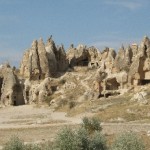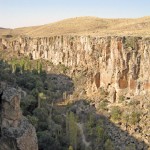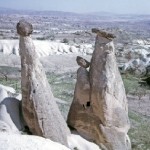
In the early afternoon of Wednesday 14th October 2009, we drove into the town of Ürgüp, located in the central Anatolian region usually known by its ancient name of Cappadocia. Here the landscape in places looks more lunar than earthly! This is the result of eruptions from two or three nearby, now extinct volcanoes, which covered the surrounding area with volcanic lava and ash. The resultant landforms are quite spectacular and attract many visitors.
Driving into Ürgüp, we spotted the Melis Hotel and went to enquire about the cost and availability of rooms. The hotel attracted me for two reasons. One was that it was a well preserved old building, very much in keeping with the surrounding landscape. Subsequently, I discovered that it is a 300 year old Greek House which has been very sympathetically renovated and extended. The other attraction was that it had an outdoor swimming pool which still had water in it. Despite the daytime temperature being between 25 – 30 degrees Celsius, various other hotels we had seen in Ürgüp and elsewhere, had already emptied their pools for the forthcoming winter.
The Rev’d John Skinner, with whom we stayed at Selcuk the previous Sunday night, had wisely advised us never to pay the advertised price for a hotel room whilst in Turkey. Having been shown various rooms and been told what the ‘normal price’ for each of these was, I successfully negotiated a ‘special price’ for us staying for three nights and paying in cash with Euro notes. I got a reduction of 16.66%!!!! Something we had discovered in Croatia in July and now in Turkey, is that the role the US dollar used to have for travellers 20 – 30 years ago, has now been replaced by the Euro. Carrying and paying cash in Euro gave us better deals on numerous occasions during our trip.
The outstanding feature of the Cappadocian landscape is one that I have already featured in my previously post. Whilst the most of the lava rock surface is hard, fissures in the rock have allowed water to penetrate and erode the much softer rock beneath. Once exposed, this softer rock has then been further eroded by wind-blown sand grains. This has created in numerous parts of Cappadocia, a series of landforms usually known as ‘fairy chimneys’. They are quite extraordinary as I hope you will see from the accompanying photographs.
 |
 |
 |
 _ |
The hard caps on top of the ‘chimneys’ protect the softer rock beneath. However, the soft rock does still slowly erode, eventually causing the collapse of the chimney. The different colour and texture of the various rock layers is evident in these photos.





It seems like a whole field of toadstools. It’s been so fun reading this Turkish adventure because every single day is something new to me!
.-= Karen´s last blog ..Remembering the Fall of the Berlin Wall =-.
Hi Karen – I do agree, some of them do look like overgrown toadstools. Glad you’re enjoying the trip!
These are some really cool looking chimneys, they kind of remind me of a Super Mario Bros. game 🙂
.-= dave@home improvements´s last blog ..How To Install a Mailbox =-.
I have never seen fairy chimneys before, interesting to know how they’re formed that way. The fairy chimneys in shape of a swan reminds me more of a camel, but I guess a swan gives off a more elegant thought process.
Those are some very exciting rock formations. It’s always interesting how world functions over time, in this case creating beautiful landscapes.
.-= Carl@Home Improvement prices´s last blog ..The Best Mouse Traps to Exterminate Mice on Your Own =-.
Thanks for sharing the great photos. I’d heard of the slightly phallic Fairy Chimney’s before, but unfortunately I’ve never had the opportunity to travel outside Istanbul.